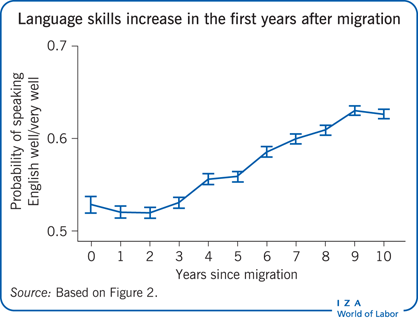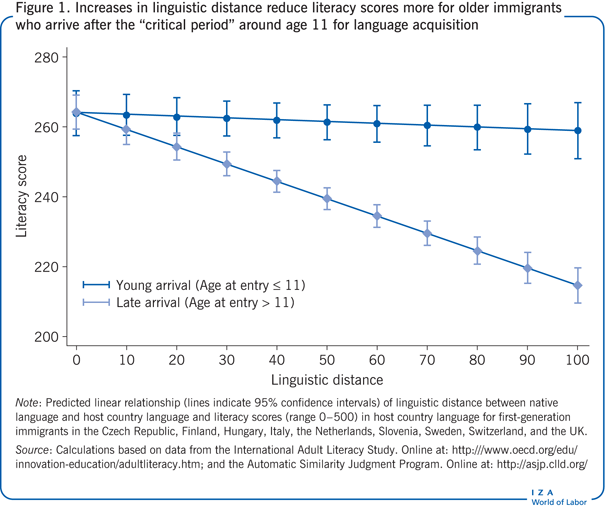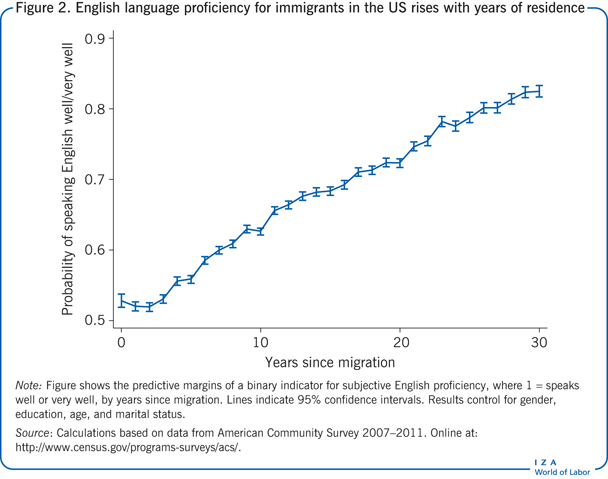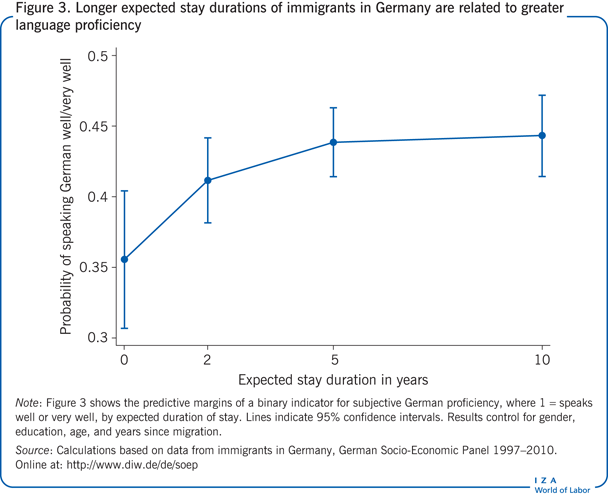Elevator pitch
Language proficiency is a key driver of immigrant integration. It increases job opportunities and facilitates social and political participation. However, despite its vital importance, many immigrants never reach adequate proficiency in the host country language. Therefore, insights into the underlying processes and associated factors are crucial for designing measures to improve language acquisition. Empirical evidence shows that immigrants differ in their ability to learn languages, in their experience of everyday language usage, and their incentives to learn host country languages. This offers a range of opportunities for public policy intervention.

Key findings
Pros
Immigrants arriving during childhood effortlessly acquire the primary language of the host country.
Language skills increase with time spent in the destination country through exposure and learning by doing.
Higher wage returns and better job opportunities create incentives to invest in the acquisition of languages.
Point-based immigration selection rules, language classes, and citizenship incentives are policy options that can be used to encourage language acquisition.
Cons
Greater linguistic distance between the native language and the host country language increases the difficulty and cost of language acquisition.
Living in ethno-linguistic enclaves reduces exposure to the host country language and thus opportunities to use it regularly.
Circular migration and short expected durations of stay decrease incentives for language acquisition.
The efficiency of language acquisition is also influenced by characteristics that are not observed in the data and can only be approximated, such as motivation and cognitive abilities.
Author's main message
Immigrants who fail to achieve adequate proficiency in the host country language generally fail to achieve economic and social integration. The language skills of immigrants differ along a range of observable and unobservable characteristics. Language skills increase with the time spent in the host country and in response to higher wage and job incentives. Insights into differences in immigrant characteristics offer opportunities for public policy intervention to improve integration through better language acquisition. Promising policy options include point-based immigration selection rules, language classes, and citizenship incentives.
Motivation
Being able to communicate in the host country language is one of the main drivers of successful economic and social integration of immigrants. Low levels of language proficiency create high hurdles to participating in the labor market, joining in the political process, and engaging in everyday social interaction. Having adequate language skills allows immigrants to progress along the job ladder, increases their employment probability, and eases their access to better-paying jobs. Despite the importance of language acquisition, proficiency levels remain low among large segments of immigrant populations. Understanding the underlying processes of language acquisition and the factors associated with acquiring proficiency is vital for designing effective policy measures to increase language acquisition and economic and social integration of immigrants. This paper surveys the empirical literature on factors associated with language acquisition and links this evidence to potential policy measures.
Discussion of pros and cons
Why acquiring proficiency in the host country language is important
Language skills are a vital part of an immigrant’s human capital. Acquiring adequate proficiency in the host country language is an important driver of immigrant economic and social integration. The importance of language proficiency for successful labor market integration stems from at least two distinct roles of language skills.
First, as the primary medium of communication, language skills are a productive trait in themselves, and employers are willing to reward the higher productivity of workers who are language proficient. This wage effect of language skills combines a direct effect of being remunerated for higher productivity and an indirect effect of having easier access to well-paid, communication-intensive jobs, thus preventing occupational segregation.
Second, language skills are complementary to the education and experience acquired before migration and facilitate the transfer of these skills into the new job environment. Language skills also ease the acquisition of additional education and experience in the host country. The influence of language skills extends beyond the economic success of immigrants. In addition to helping immigrants integrate into the labor market, language skills also crucially affect such non-market outcomes as education, health, marriage, social integration, and political participation.
Despite the importance of language acquisition, proficiency levels remain low for large segments of the immigrant population. Low language proficiency is often highlighted as a contributor to failed integration, and it can fuel anti-immigration attitudes. Nonetheless, some immigrants do gain adequate proficiency in the host country language. Thus, it is of great concern to identify the driving influences and associated factors behind immigrant decisions to invest in acquiring host country language skills and understand why some immigrants learn the host country language and others do not.
Factors contributing to immigrants’ acquisition of the host country language
Economists tend to interpret proficiency in the host country language as part of an immigrant’s human capital. As such, it is costly to acquire, inseparably connected to the individual, and generates higher labor market returns through increased productivity. In deciding on optimal effort and commitment to acquire language skills, immigrants trade off the expected benefits of language proficiency and the costs of acquisition.
The benefits of language acquisition arise through the rewards of higher earnings, better employment probabilities, access to better jobs, and achievement of non-market gains through social and political participation. The costs of language skill acquisition include effort, time, the cost of language classes, and the indirect costs of forgone earnings (opportunity costs) while learning the language. Both the benefits and the costs of language acquisition are related to observable influencing factors. In seminal work on this issue, the determinants were classified into three groups: those shaping the ability and efficiency of acquiring a new language, those affecting the degree to which immigrants are exposed to the host country language, and those that set economic incentives for acquiring the language [1].
Ability and efficiency in learning a new language
The first group of influencing factors affects the efficiency of learning a new language. Immigrants differ in how much of an investment in resources (time, money, effort) they need to make in order to reach a certain level of language proficiency. The most decisive factor is the age of arrival in the host country. The ability to learn new languages declines strongly with age. Immigrants arriving in the host country before adolescence almost effortlessly acquire the host country language at a proficiency level that equals or almost equals that of native speakers. Immigrants arriving at an older age face greater difficulty in acquiring a new language. Linguists and neurobiologists label this the “critical period” hypothesis and identify a structural break in the ability to acquire a new language in early adolescence (around the age of 11) [2].
Linguistic distance—the degree of dissimilarity between two languages in vocabulary, grammar, pronunciation, and other elements of a language—is an important source of variation in language acquisition. The greater the linguistic distance between the immigrant’s native language and the host country language, the higher the costs associated with reaching a certain level of language proficiency. Various methods have been applied to assess the effect of linguistic distance empirically. Approaches draw from linguistic research on differences among languages, or they deduce linguistic distances from the average effort of foreign language students who share a common native language to reach certain proficiency levels. A strong relationship between linguistic distance and achieved levels of language proficiency has been documented using German, American [3], and Canadian microdata [2] and results on international tests [4].
The impact of the interaction between linguistic distance and age at arrival on language acquisition varies with age on arrival. Young arriving immigrants do not face additional penalties in their language acquisition as a result of greater linguistic distance. However, for immigrants arriving after the critical period for language acquisition, the combined impact of large linguistic distance and late arrival is considerable. Evidence from international literacy test scores indicates that foreign-language speaking immigrants arriving at a young age have lower initial test score gaps by about half a standard deviation in literacy compared with native-language speaking immigrants. This effect increases to about a full standard deviation for immigrants who arrive after the critical period for language acquisition in early adolescence [3].
Figure 1 depicts this relationship between linguistic distance and language proficiency (as measured by literacy scores of first-generation immigrants in the International Adult Literacy Study) at young and older ages. The data are based on a sample of immigrants in the Czech Republic, Finland, Hungary, Italy, the Netherlands, Slovenia, Sweden, Switzerland, and the UK. The applied measure of linguistic distance is differences in pronunciation, as, for example, in [4]. For immigrants who arrive before early adolescence literacy scores decline only modestly with increases in linguistic differences between their native language and the host country language. For immigrants who arrive after the critical period, the effect of larger linguistic distances on language acquisition becomes significantly stronger.

The efficiency of language acquisition is influenced by other characteristics in addition to age at entry and linguistic distance between native language and host country language. These other characteristics are generally not observed in available data sources and can only be approximated. Examples of these unobserved influences are motivation and cognitive abilities. Motivation for language acquisition differs along with the reasons for migrating. Having migrated for security reasons, as indicated by refugee status, is generally negatively correlated with achieved levels of language acquisition. Immigrants who have migrated for economic reasons tend to have higher levels of proficiency.
Still, this difference in motivation may mask other differences in the initial migration decision between refugees and economic immigrants. The ability and efficiency of language acquisition are expected to rise with cognitive ability, which is typically not observed in the data. Proxies for cognitive ability, such as individual and parental educational attainment, are positively correlated with achieved levels of language proficiency. These relationships between efficiency-affecting variables and language acquisition have been documented for a range of countries, including Canada, Germany, Israel, and the US, based on data on international test scores [1], [2], [4].
Degree of exposure to the host country language
Immigrants do not necessarily learn the host country language in an organized institutional setting, such as in language classes. Most immigrants acquire the host country language through daily exposure and through involvement in day to day activities (learning by doing). Exposure to the host country language can happen both before and after migration. Before migration, immigrants differ in whether—and how well—they learned the host country language in school or in adult language classes in the home country.
Many countries have specialized institutions to promote their culture and language abroad. By providing subsidized language classes, these institutions aim at (among other goals) making a country a more attractive destination for international migrants. Examples of these institutions are the German Goethe Institute and the French Instituts Français. Pre-migration exposure might also take place through foreign language education in school or exposure to foreign language television programs, books, or other media. Information on this pre-migration exposure of immigrants is typically not available. Instead, studies use historical ties, geographic proximity, and common borders as indicators of a higher likelihood of pre-migration exposure. Studies using microdata for Canada, Germany, and the US find these indicators to be positively associated with host country language proficiency levels [2], [4].
For language exposure after migration, a simple summary measure of cumulative exposure and additional investments in language acquisition is the number of years in the host country since migration. Figure 2 and the depict the positive relationship between time spent in the country and the probability of speaking the host country language well (in this case English for immigrants in the US). This simple representation hides a large degree of heterogeneity, however. How the time spent in the host country positively affects language acquisition is again associated with a number of different factors.

A key factor determining the degree of exposure to the host country language is locational choice. Immigrants tend to move into ethno-linguistic enclaves inhabited by earlier immigrants with the same ethnic background, to benefit from existing ethnic networks and easier access to ethnic goods. While living in an ethnic enclave can have initial positive effects on employment probabilities, it can impede acquisition of the host country language by reducing exposure to the host country language. Because many day-to-day tasks can be achieved within the enclave while communicating in one’s native language, living in an ethnic enclave reduces the need to use the home country language in everyday living. Ethnic enclaves also increase the probability of working for and with people of the same ethnic background, which reduces the need to use the host country language on the job.
Not surprisingly, a negative relationship has been documented between enclave density and host country language acquisition for a range of settings. For the US, the probability of an immigrant learning English has been shown to be negatively related to the size of populations in the area who speak the same native language [5]. Similar relationships have been documented between ethnic minority density in an area and average host country language skills of immigrants of that ethnic minority for Australia [6], Canada and Israel [1], and the UK [7]. Still, because investments in language skills and locational choice are joint decisions, the direction of causality might run in both directions. Thus, language skills can affect the probability of living in an ethnic enclave just as living in an ethnic enclave can affect language acquisition.
Exposure to the host country language might also depend on family dynamics. The impact of family members who are fluent in the host country language is ambiguous. Fluent family members might act as interpreters, reducing incentives to learn or apply the host country language, or as teachers, improving language acquisition. Having children might increase social interaction with the native-born population, but it might also detach the primary care-giving parent from the labor market. A US study using census data finds high correlations between the language proficiency of immigrant spouses but cannot rule out spurious relationships by assortative matching in motivations and cognitive ability—meaning that individuals with similar language motivation and cognitive ability might be more likely to select each other as mates [8]. The number of children is unrelated to the language skills of fathers but has a significantly negative relationship with the language skills of mothers, supporting the view that primary care-givers are negatively influenced in their language acquisition.
A special case of family dynamics is that of marriage between natives and immigrants. While causality can again run both ways, with language skills leading to intermarriage or being affected by it, there is a clear positive relationship between the level of proficiency and having a native-born spouse. One study finds distinctly faster rates of language acquisition for intermarried immigrants in Australia [9].
Economic incentives for acquiring the language
Finally, besides differing in ability and exposure, immigrants differ in their incentives for learning a new language. These incentives consist mainly of better-quality jobs, higher wages, and higher employment probabilities. Causal effects of language skills on wages have been estimated for Germany [10], the UK [7], and the US [11]. These labor market rewards for language proficiency set incentives for forward-looking immigrants to invest early in language acquisition.
Incentives for investing in language skills are also influenced by the expected length of stay. The longer an immigrant plans to stay in the host country, the longer the period in which to benefit from the acquired language proficiency. Migrants who travel back and forth to and from their home country (circular migrants) and who plan to return after a short time in the host country might have lower incentives to invest in language acquisition than permanent or long-term immigrants. Investments in language skills and decisions on the duration of the stay are interrelated economic decisions. Estimates based on German survey data indicate that investments in language proficiency are sensitive to the expected stay duration [12]. Figure 3 depicts this relationship: longer expected stay durations in a host country, which mean longer periods of expected earnings, are positively related to the level of language proficiency. This also indicates that factors preventing the language acquisition of immigrants might lead to a selective return migration of those who do not reach sufficient proficiency levels.

Finally, decisions on language acquisition can take place before migration occurs. Potential migrants may consider the costs and benefits of acquiring a specific host country language when deciding where to migrate. Everything else being equal, immigrants tend to move to countries where the expected costs of language acquisition are lower.
Limitations and gaps
Although the descriptive literature on the factors that can influence immigrants’ acquisition of the host country language is comprehensive, studies assessing the causal effect of single factors on language acquisition are almost non-existent. The main reason for this lack of causal studies is the lack of appropriate data sets. In most cases, studies have to rely on self-reported data where immigrants are asked to self-assess their knowledge of the host country language. This kind of information has been shown to be very imprecise, and the errors in subjective assessment are likely to depend on precisely the variables the study wants to examine. Further, common data sources lack crucial information—for example on individuals’ native language, cognitive ability, and motivations for migrating.
There are also no studies on the influence of private language instruction in home and host countries on immigrant selection and immigrant economic and social integration. There is a growing international market of language instruction companies.
Finally, except for [13], there is a lack of evidence on the effectiveness and efficiency of public policy measures aimed at influencing language acquisition. Again, this is likely driven by the lack of data on participation in language courses, the self-selection of immigrants, and the difficulty of constructing counterfactual situations (what would have happened if the policy measures had not been introduced).
Summary and policy advice
Proficiency in the host country language is vital for the economic and social integration of immigrants. It raises productivity by improving access to higher-paying jobs, and facilitating interactions with the native-born population. Despite these important benefits, host country language proficiency levels remain low for large numbers of immigrants.
Factors that affect immigrants’ acquisition of the host country language act by influencing the ease or difficulty of learning a specific language, the degree of exposure to the host country language, and the incentives for acquiring the language. The ability to learn a new language is affected by the immigrants’ age at arrival, the linguistic distance between the native language and the host country language, reasons for migrating, and cognitive ability and education. Immigrants differ in their exposure to the host country language before migration and as a result of differences in home country foreign language education and exposure to foreign media. After migration, exposure to the host country language differs by location (whether in an ethnic enclave or not), family composition, and marriage to a native. Finally, differences in expected returns in wages and employment prospects and differences in the expected length of stay in the host country create different incentives for language acquisition.
Policymakers have at least three broad ways to affect the language acquisition of immigrants through public policy measures. While there are few empirical studies of the effectiveness of public policy measures, the suggested policy channels do draw directly on the empirical base of factors influencing the language acquisition of immigrants. The most straightforward option is to subsidize language classes. As an example, Germany introduced mandatory measures to improve immigrant integration in 2004, consisting mainly of subsidized German language courses. Language instruction subsidies can even boost language class participation in the home country before migration, through organizations like the German Goethe Institute and the French Instituts Français, which offer affordable language classes around the world.
Another policy measure is directed at influencing who migrates to the country. Point-based selection policies can base immigration admissions either directly on language skills or favor immigrants who are expected to achieve proficiency quickly. For example, point-based systems in Australia and Canada favor immigrants who are young and well-educated, factors shown to be positively associated with language acquisition.
Finally, public policy can affect the incentives for language acquisition through citizenship policies. Easing the way to citizenship for immigrants who can contribute the most to the country and its economy can incentivize investments in country-specific knowledge, especially language skills, by raising the willingness of immigrants to commit themselves to the country and to remain there longer.
Acknowledgments
The author thanks two anonymous referees and the IZA World of Labor editors for many helpful suggestions on earlier drafts.
Competing interests
The IZA World of Labor project is committed to the IZA Guiding Principles of Research Integrity. The author declares to have observed these principles.
© Ingo E. Isphording